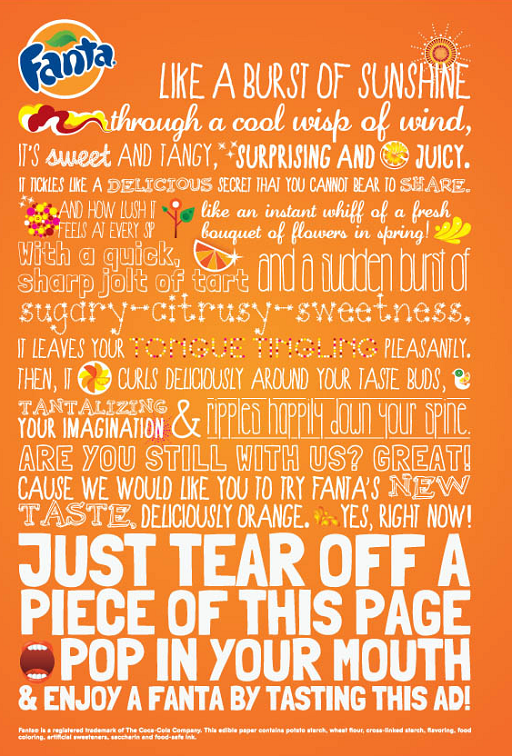4 New, improved! Adjectives and advertising
Advertising is designed to make you think that a product or service is better than alternative products/services. Whatever that ‘something’ is – a holiday, a car, a type of cheese, a large piece of furniture, or even a political party – adjectives can be used to try and sway your opinion.
If you look at adverts carefully and critically, you can start to work out what suggestions and associations advertisers are trying to suggest to their target consumers.
Activity 6 Advertise with adjectives
What different sorts of product might be advertised using these adjectives? Jot down some products (or types of products) which come to mind.
- unique
- fast-acting
- timeless
- effective
- gentle
- exclusive
- mellow
- fascinating
- natural
- reliable
- handy
- distinctive
- all-new
- convenient
- luxury
Discussion
While all of these adjectives are positive, some seem to be about whether a product is good at its job (fast-acting, gentle, handy), while others suggest that the product is special in a less specific, not necessarily practical way (unique, exclusive, luxury). What these latter adjectives might mean is hard to pin down.
How, exactly, would a luxury soap bar be different from an ordinary one? Could luxury be used to describe any product? There’s certainly luxury toilet tissue, and luxury chocolates, but would you expect to find luxury bleach or luxury pan scrubbers?
A recent extensive survey of advertising for high-end brands found that, whether they were selling perfume, leather coats or watches, the most common adjectives were of the non-specific kind – the most frequently used of all was exceptional (TranslateMedia, 2017).
This suggests that a fundamental decision has to be made before creating an advertisement – will the advertisers focus on the practical qualities of the product, or the reputation and aura of the brand? This probably depends a lot on the price of the product, and what sort of competition it faces. Whatever the decision is, it will almost certainly have an effect on the choice of adjectives used.
Look at adverts for products you are interested in (mobile phones perhaps? shoes? holidays abroad?) and compare the amount of emphasis on the practical aspects of the product and the amount of emphasis on the brand. How does this affect the adjectives used?
Activity 7 Analyse the adjectives in an advert
Read through the advert below for the soft drink Fanta. List all the adjectives you can find.

Please note that, to make it easy to read, the text of the advertisement is reproduced below.
Fanta. Like a burst of sunshine through a cool wisp of wind, it’s sweet and tangy, surprising and juicy. It tickles like a delicious secret that you cannot bear to share. And how lush it feels at every sip like an instant whiff of a fresh bouquet of flowers in spring! With a quick, sharp jolt of tart and a sudden burst of sugary-citrusy-sweetness, it leaves your tongue tingling pleasantly. Then, it curls deliciously around your taste buds, tantalizing your imagination & ripples happily down your spine.
Are you still with us? Great! Cause we would like you to try Fanta’s new taste, Deliciously Orange. Yes, right now! Just tear off a piece of this page, pop in your mouth & enjoy a Fanta by tasting this ad!
Fanta is a registered trademark of The Coca-Cola Company. This edible paper contains potato starch, wheat flour, cross-linked starch, flavouring, food colouring, artificial sweeteners, saccharin and food-safe ink.
Discussion
From the main advertisement text: cool, sweet, tangy, surprising, juicy, delicious, lush, instant, fresh, quick, sharp, sudden, sugary-citrusy, Great, new.
And from the ‘small print’: registered, edible, cross-linked, artificial, food-safe.
The advert text mostly uses short, punchy, positive adjectives. The one original item is sugary-citrusy which goes with sweetness. Together they form a phrase that extends across the whole width of the page, possibly to suggest the mouth-filling burst of flavour after that first sharp jolt. With this exception, the use of adjectives is relatively conventional, and the vibrant colour and varied lettering of the advert seem to make as much of an impact as the language here.
We can contrast the main advertisement with the administrative language of the small (in fact tiny!) print at the bottom of Fanta the advert, which lists the ingredients not of Fanta, but of the paper the advert is printed on. This is presumably a legal requirement, as artificial is unlikely to be something the manufacturers would want potential customers to associate with their product.
